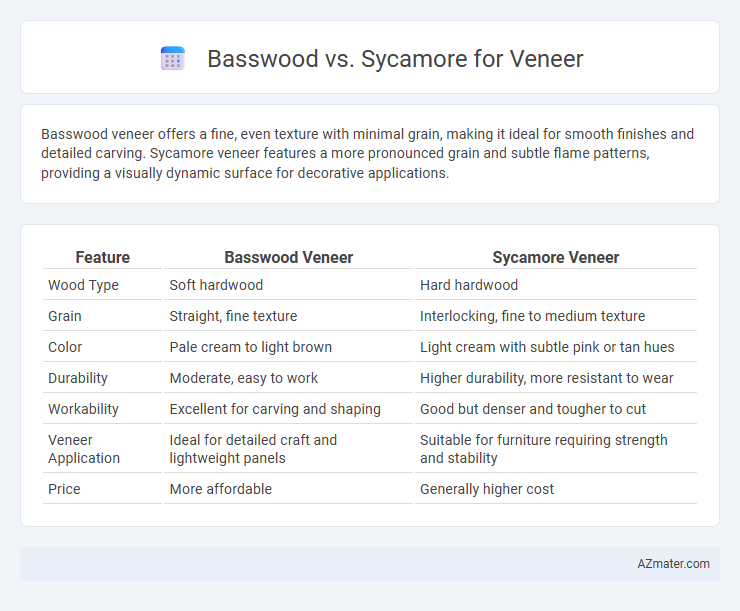Basswood veneer offers a fine, even texture with minimal grain, making it ideal for smooth finishes and detailed carving. Sycamore veneer features a more pronounced grain and subtle flame patterns, providing a visually dynamic surface for decorative applications.
Table of Comparison
| Feature | Basswood Veneer | Sycamore Veneer |
|---|---|---|
| Wood Type | Soft hardwood | Hard hardwood |
| Grain | Straight, fine texture | Interlocking, fine to medium texture |
| Color | Pale cream to light brown | Light cream with subtle pink or tan hues |
| Durability | Moderate, easy to work | Higher durability, more resistant to wear |
| Workability | Excellent for carving and shaping | Good but denser and tougher to cut |
| Veneer Application | Ideal for detailed craft and lightweight panels | Suitable for furniture requiring strength and stability |
| Price | More affordable | Generally higher cost |
Introduction to Basswood and Sycamore Veneer
Basswood veneer is prized for its smooth texture, light color, and fine, even grain, making it ideal for intricate woodworking and high-end furniture surfaces. Sycamore veneer features a distinctive, subtle grain pattern with a warm, creamy hue that enhances visual interest and adds a natural, elegant touch to cabinetry and paneling. Both veneers offer durability and versatility, but Basswood is preferred for consistent appearance while Sycamore is favored for decorative, unique grain effects.
Botanical Background and Origins
Basswood, botanically known as Tilia americana, is a deciduous hardwood native to eastern North America, prized for its pale, fine-grained veneer. Sycamore, primarily from the Platanus genus such as Platanus occidentalis, originates from the eastern and central United States, recognized for its distinct variegated grain and robust texture. Both woods offer unique aesthetic qualities for veneers, with Basswood valued for its smooth finish and Sycamore for its striking natural patterns.
Appearance and Grain Patterns
Basswood veneer features a fine, even grain with a light, creamy color that offers a smooth, consistent appearance ideal for modern, minimalistic designs. Sycamore veneer showcases a more intricate grain pattern with subtle waves and occasional birdseye or fiddleback figures, presenting a warm, varied texture that enhances traditional or decorative applications. The uniformity of basswood contrasts with the visually dynamic and textured appeal of sycamore, influencing the choice based on desired aesthetics and design complexity.
Workability and Machining Qualities
Basswood veneer exhibits excellent workability due to its fine, even texture and softness, making it easy to cut, shape, and sand without chipping or splintering. Sycamore veneer, while slightly harder and denser, offers good machining qualities but requires sharper tools and slower feed rates to prevent burn marks and tear-out. The softer nature of basswood facilitates smooth gluing and finishing processes, whereas sycamore provides a more durable and wear-resistant surface ideal for high-traffic applications.
Durability and Lifespan
Basswood veneer is known for its moderate durability, offering a stable surface that resists warping but is softer and more prone to dents compared to sycamore. Sycamore veneer provides superior hardness and wear resistance, making it more durable for high-traffic applications and extending the lifespan of furniture and cabinetry. When longevity and tough surface performance are critical, sycamore is the preferred choice over basswood for veneer use.
Weight and Density Comparison
Basswood veneer exhibits a lower density, averaging around 320 kg/m3, making it significantly lighter than Sycamore veneer, which typically has a density near 740 kg/m3. The lightweight nature of Basswood is ideal for applications requiring easy handling and minimal structural load, whereas Sycamore's higher density provides greater durability and resistance to wear. Choosing between Basswood and Sycamore veneers depends on the balance between weight sensitivity and strength requirements in specific woodworking projects.
Cost and Market Availability
Basswood veneer is generally more affordable than sycamore due to its faster growth rate and wider supply, making it a cost-effective choice for budget-conscious projects. Sycamore veneer, valued for its distinctive grain and aesthetic appeal, commands higher prices and is less readily available in the market, often sourced from limited regional suppliers. Market availability of basswood remains steady year-round, while sycamore seasonal fluctuations and regional scarcity affect lead times and pricing stability.
Environmental Impact and Sustainability
Basswood veneer is favored for its fast growth rate and renewable nature, contributing to lower environmental impact through rapid carbon sequestration and sustainable harvesting practices. Sycamore, while offering a denser wood structure, typically grows slower, which may result in a higher ecological footprint due to longer cultivation periods and less frequent harvest cycles. Choosing basswood supports sustainable forestry by minimizing resource depletion and promoting ecosystem balance compared to the more resource-intensive sycamore veneer production.
Common Applications in Veneering
Basswood veneer is prized for its fine, uniform grain and light color, making it ideal for detailed cabinetry, musical instruments, and intricate marquetry. Sycamore veneer features a more pronounced, wavy grain pattern with a slightly coarser texture, commonly used in furniture panels, decorative wall coverings, and architectural millwork. Both woods provide excellent workability, but basswood favors precision work, while sycamore suits projects requiring a distinctive, textured aesthetic.
Choosing Between Basswood and Sycamore
Basswood veneer offers a smooth, fine grain ideal for detailed carving and uniform finishes, making it perfect for delicate or painted furniture surfaces. Sycamore veneer features a more pronounced grain pattern with subtle figure variations, providing an attractive, natural look suited for decorative paneling and unique wood accents. When choosing between basswood and sycamore veneers, consider basswood for precision work and sycamore for visual texture and warmth in design.

Infographic: Basswood vs Sycamore for Veneer
 azmater.com
azmater.com